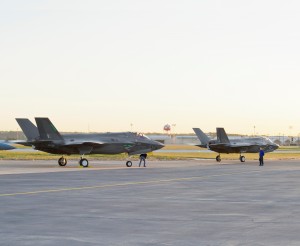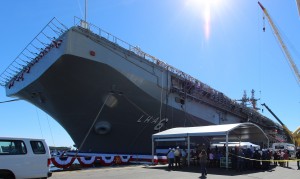2012-10-19 By Robbin Laird
I am attending the christening event for the new America class ship which will be held October 20, 2012. And have had the opportunity to discuss the ship with several key players in developing and defining the new ship.
Discussions have been held with the prospective Captain of the Ship, Captain Robert A Hall, Jr., with the Irwin Edenzon, President of Ingalls Shipbuilding and with Captain Chris Mercer, US, program manager for the ship.
I will be reporting on these discussions in the coming days.
But this large new ship which is to replace the USS Pelelui, is built for a new age.
It is aviation centric and built to serve the Osprey, the F-35B and the new CH-53K. It is designed to be a flag ship for an Expeditionary Strike Group and to provide significant reach and coverage for a strike force.
The Osprey has started the revolution in reach and coverage. It has been re-shaping the Amphibious Ready Group and Marine Expeditionary Unit to provide for more flexibility and reach.
With the addition of the F-35 Bravo, this reach and coverage will be extended.

The ship is designed to support a full complement of 19 to 23 F-35Bs or a mix and match capability with various other aviation and strike assets.
The ship leverages several innovations seen in recent shipbuilding, including the propulsion plant of the Makin Island. It is providing an innovative re-definition of how aviation intersects with the insertion of the ground element into operations.
And the planning for the F-35B includes shaping new approaches to work flow and sustainment at sea which are also being leveraged by the large deck carriers as they prepare for the coming of the F-35C.
Captain Mercer highlighted the regular interaction between those building the America and those building the Ford class large deck carriers.

And as Captain Hall put it:
We are aviation centric large deck amphibious ship designed without a well deck but operate in a fleet which can deliver amphibious vehicles. The ship has been designedto support this next generation of aircraft, which is larger and also we need to support greater sortie generation rates of which the F-35 is capable. The ship has been designed to have space to perform maintenance for the aircraft and to provide for extra fuel to support the sortie rates of which the aircraft tis capable. We will have room for much greater amount of ordinance and storage of parts as well.
The ship and its aviation capabilities will provide the joint force commander with a powerful new tool.
Edenzon emphasized that this ship compared to older amphibious ships is much more complex. The company has done many innovations to deal with complexity and to drive down risk.
It is a large ship, and much of the work has been done out of the water. A much greater proportion of the ship has been built in the factory compared to older ships.
Instead of doing piece work, they have emphasized factory work.
He underscored his concern that delaying the ships to be built after the next one and that provides a significant challenge to keep a trained workforce in place. This also drives up the challenge of risk reduction as well.
Ship to ship learning is a crucial element of the production process. Stability in production volume to leads to stability in production learning.
The video below was shot during the media day event on October 19th. I apologize for the background noise, but it is a shipyard.
Irwin Edenzon, President of Ingalls Shipbuilding, discusses the America Class Ship from SldInfo.com on Vimeo.
Some of the basic capabilities of the ship and the bios of the some of the principals is contained below.

